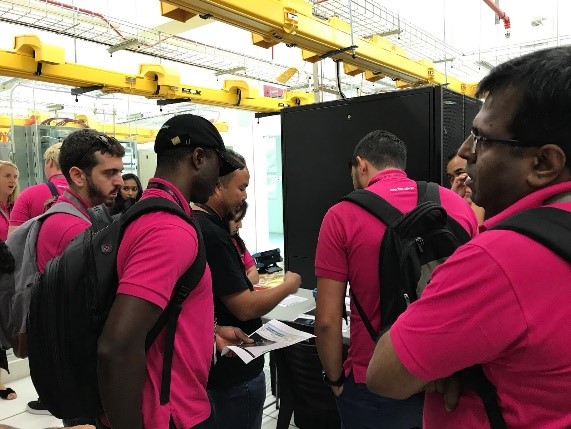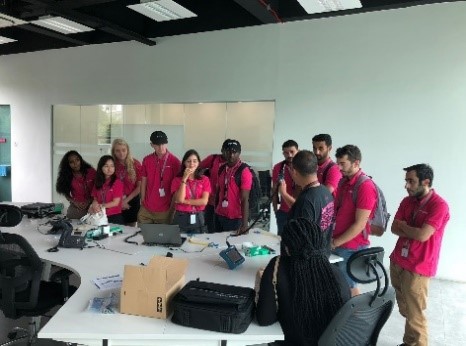
The interns learning about TIME’s quality procedure.
By Dina Possamai
During our third week, we got a chance to visit Penang, an island in the northwest of the country. The main aim of this trip was to understand the importance of quality testing of TIME; global connectivity and rigorous testing methods to ensure quality and pool proof data testing methods. We visited the second cable landing station (CLS) where we went to look at the technical aspects of global data connectivity including data loss identification, recovery and preventive methods used. We also had the opportunity to explore the UNESCO world heritage island; a city of art and food heritage in Malaysia. This blog’s narrative explains the key learnings such as technical and cultural aspects of our trip.
We spent most of our time on Saturday exploring the different tasks in receipt and distribution of data. Unlike the Kuantan CLS, the one in Penang connects Malaysia to the West, traveling to Egypt and ending in Marseilles, France (the AAE-1 cable network). TIME Penang employee, Mr. Abdul Rahim, demonstrated the functioning of cable dusting, cleaning and error identification procedures.
The first task of quality procedure introduced to us was the cleaning of the connecting ends of the fiber. The cleaning of the fiber is compulsory or else the overall performance of expected data transmission is decreased. We got hands-on experience to learn basic cleaning with wipes to probes and dust identification procedures. We then entered the Back-Haul Room, which involves processing of submarine fiber cables data from various global locations to several terrestrial sites. Finally, we entered the SLTE Room which is the last stage of the process where it allows to simulate the error location using complicated circuits. In this stage, we attempted to understand the Test Gear known as Exfo Machine, which has various complex features to figure out an error in transmission. In my view, the machine simulates both physical and soft loop circuits. The company made a substantial effort to explain the functioning of critical network testing procedures to non-technical graduates in a lucid and simple way. The company representatives demonstrated the functioning of the machine and analysis using a dummy scenario of data transfer between two locations. Furthermore, the physical and soft loop circuit simulation helps to identify the faults in the transmission and the method of boosting the data with the help of repeaters devices. Moreover, it was amazing to see the monitoring function of the device.

TIME Penang employee, Mr. Abdul Rahim, demonstrated the functioning of cable dusting, cleaning and error identification procedures.
In my view, as a business student, the demonstration enabled me to understand the intricacies of learning engineering aspects and emphasis on benefits of in-depth understanding of technical aspects. I personally believe this is the rarest opportunity that kindled my passion to learn interdisciplinary knowledge to be a successful manager. This trip uncovered the importance of technical knowledge other than the managing process and people, which has been extensively covered in my business studies. Furthermore, the trip signposted me the essentiality of abundant knowledge and open-mindedness to be successful in the managerial role.
Other than technical learning, we were exposed to appreciate the cultural heritage of the island. In particular, TIME employees emphasized the food heritage of Penang from day one of our internship visit. To test and experience the heritage theories, I decided to venture outside of my comfort zone and indulge tasting the local street food. Interestingly, when I tried a seafood noodle dish, after our technical trip to CLS, the majority of the group decided to wait for one and a half hours to try one of the most famous and praised dishes i.e. Mee Sotong a local noodle with seafood and orange color syrup which I haven’t seen anywhere before this trip. Later in the evening, we continued queuing to visit an important scenic landmark Penang Hill for what seemed like hours in order to go up the Hill and check out the lit skyline. But was the view worth that wait … well that is a matter of personal opinion.
On the art side, I loved the diverse culture of Penang with tiny streets in Chinatown and Little India, buzzing with noise and culture which almost reminded me being in China and India and I can see the reflection of integration almost in terms of architectural marvel, food, people habits, and mutual religious respects. This is a memorable learning trip for my career.

A view of Penang from Penang Hill.


Leave a Reply